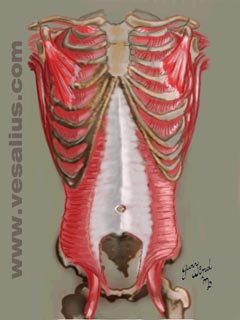Transversus abdominus
Viewed in the sagittal plane, the transversus abdominus' lines of application are essentially parallel to the intervertebral joints' (IVJ) lateral axes. Therefore, transversus abdominus produces no moment around that axis; it neither flexes nor extends the lumbar spine.
Viewed in the frontal plane, the muscle's lines of application have at best very short moment arms with regard to the IVJ antero-posterior axes. In fact, individual fibers proceed from their lateral attachments horizontally to the linea alba in such a way that they do not truly "cross" any intervertebral joints; no fiber begins, for instance, at the level of L4 and ends at the level of L3 or L5. This observation leads us to predict that the muscle has little effect on lateral flexion (sidebending).

| |
|---|
In Muscles: Testing and Function, Kendall (1993) states that "this muscle has no action in lateral flexion except that it acts to ... stabilize the linea alba, thereby permitting better action by anterolateral trunk muscles." (Kendall's reference to the anterolateral trunk muscles involves the internal and external obliques.)
Finally, viewed in the transverse plane, the transversus
abdominus' line of application is similar to that of the obliques. This observation might lead us to predict that the muscles causes rotation if only the right or left transversus abdominus acts by itself.
(However, it might be hard to predict the direction of any rotation the muscle would produce. If the lateral attachments are stable, it might rotate ipsilaterally, like the internal oblique. If the midline (linea alba) attachments are stabilized, it might rotate contralaterally, like the external oblique.)
Kendall and others agree that the muscle has little effect on rotation. We might understand their observation in terms of the fact that none of the muscle's individual fibers cross any iintervertebral joints.
The muscle does have functions. Acting more or less isometrically on one side of the trunk, the transversus abdominus will stabilize the linea alba so the obliques on the opposite side may act on the trunk. We also know the muscle acts bilaterally, when shortening of its fibers causes the anterior abdominal wall to become flatter. This is useful in those activities when we need to pressurize the abdominal cavity, as in childbirth, defecation, or coughing.
References:
Kendall, F.P., McCreary, E.K., & Provance, P.G. (1993). Muscles: Testing and Function. (4th ed.). Baltimore:Williams and Wilkins.

